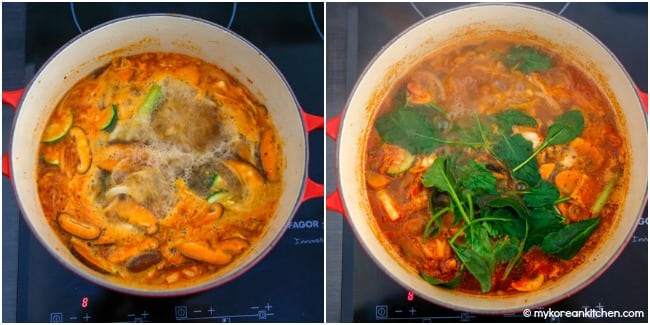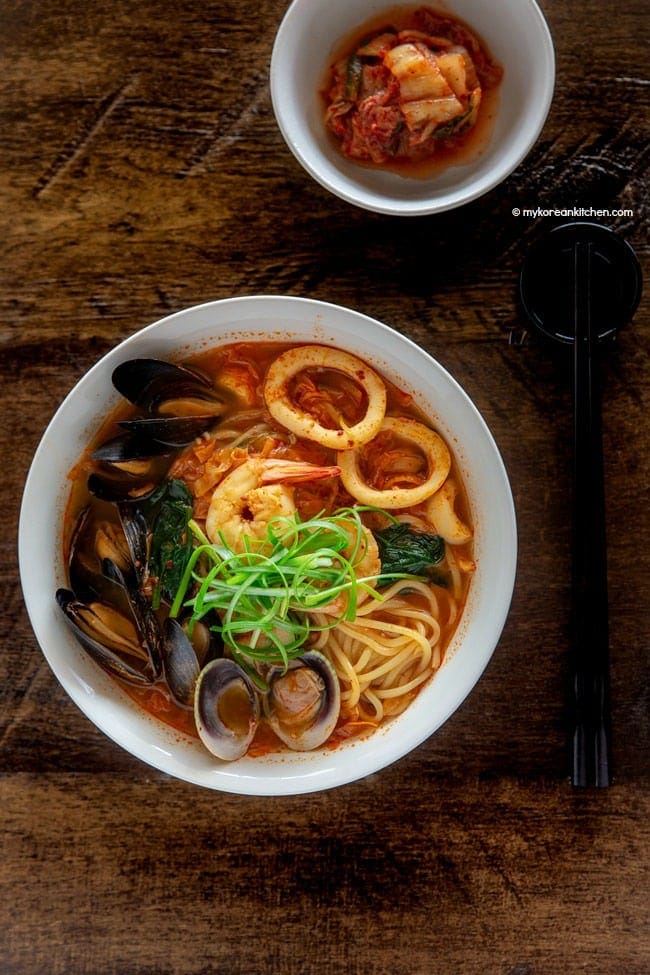Jjamppong / Jjampong (짬뽕) is a popular Korean spicy noodle soup that is loaded with various type of seafood. It tastes very refreshing and comforting!

Every now and then I have a craving for Jjamppong (Korean spicy seafood noodle soup).
Fiery looking red hot soup can be intimidating to some people, but I have to say, the soup is very addictive, refreshing and comforting!
What is Jjamppong
Jjamppong (or Jjampong, 짬뽕) is one of the most popular dishes you can order from a Korean-Chinese restaurant.
Jjamppong consists of fresh noodles, various vegetables and various seafoods and it is served in a red hot soup base. Generally the soup can be quite spicy but it can be toned down if you’re cooking it at home.
In Korea, jjamppong’s popularity always competes with jajangmyeon (Korean black bean noodles, 자장면). If you can’t decide between jjamppong and jajangmyeon, then you can order jjamjjamyeon (짬짜면) instead.
Jjjamjjamyeon is both types of noodle dishes served in a bowl that is divided in the middle. So you don’t have to compromise!
While there are many theories about the origin story of jjamppong, the most convincing version is that it was created by Chinese immigrants back in the 1940s living in Nagasaki, Japan.
Obviously the current jjamppong evolved much to suit Korean tastes. In particular, the addition of Korean chili flakes and seafood was introduced back in the 1960s in Korea.
Jjamppong Variations
There are different types of jjamppong available in Korea including the non-spicy kinds. (I’ll be sure to share these recipes with you at some other time.)
Today’s particular kind is spicy seafood noodles soup, which directly translates to Haemul Jjamppong (해물 짬뽕).
It is also possible to serve the soup without the noodles. Just serve it with some steamed rice. This dish is then called Jjamppong Bap (짬뽕밥).
Why You Should Make Jjamppong at Home
One of the best things about making Jjampong at home is that you actually get to eat a decent amount of seafood.
Typically a restaurant version doesn’t include much of it. If I’m lucky I would get 1 mussel and 1 shrimp! (No joke!) But my recipe provides a very generous amount of seafood and I think that makes a difference in the soup quality.
Also, this spicy noodle soup is particularly suitable when the weather is a bit chilly or windy. It’s really hearty and comforting! So try it this weekend and let me know how you go!
Successful Cooking Tips
- You are welcome to load the soup with even more seafood than what’s written below. It will bring out a more refreshing taste.
- Make sure the seafood is not overcooked as it can be chewy.
- For more complex flavor, some people add a small portion (about 100g / 3.5 ounces) of pork loin strips or pork belly strips. If you are going this path, add the meat before adding the seafood in step 2 below.
- If you want to add another layer of spicy flavor, use some Korean chili oil. Korean chili oil is commonly used when you make spicy soup such as today’s recipe or yukgaejang (spicy beef soup) etc. It adds nice bright red color to the dish and it brings out the rich depth of flavor. You can certainly make your jjamppong without it, but I love the outcome when I add it. So be sure to check my homemade Korean chili oil recipe. Alternatively, you can also use store bought Korean chili oil instead. I also have tried S&B La-Yu chili oil in the past and it worked well. This oil is actually a bit spicier than my homemade chili oil and gives less depth of flavor and color.
- Make sure you manage the heat well in step 1 below. The oil is very easy to burn, particularly when the chili flakes are added. It can burn really quickly and darken the color if the temperature is too high. This can give you a bit of a bitter taste and dark colored soup.
- Once you serve the noodles with the soup, allow it to soak the flavor for 3 to 5 mins.
- Any leftover soup (excluding the noodles) can be stored in the fridge for a few days. It can be reheated over the stove. (Though, seafood might have slightly overcooked texture.)
Ingredients for Jjamppong (3 servings)
Main
- 50 g / 1.8 ounces zucchini, thinly sliced
- 2 shiitake mushrooms (50 g / 1.8 ounces), cleaned, stems removed and thinly sliced
- 120 g / 4.3 ounces cabbage, thinly shredded
- 35 g / 1.2 ounces brown onion, thinly sliced
- 6 mussels (200 g / 7 ounces) or more, cleaned
- 6 littleneck clams (70 g / 2.5 ounces) or more, cleaned
- 6 large prawns (140 g / 5 ounces) or more, head & shells removed and tail left on, cleaned
- 6 squid rings or baby octopus (70 g / 2.5 ounces) or more
- 450 g / 16 ounces fresh Korean chinese style noodles (or thin udon noodles or ramen noodles)
- 20 g / 0.7 ounces baby spinach or baby bok choy
Chili Oil Seasoning
- 3 Tbsp Korean chili oil or neutral cooking oil
- 3 Tbsp Korean chili flakes (gochugaru), can be adjusted to your preferred spice level
- 1 tsp minced garlic
- 1 tsp minced ginger
- 20 g / 0.7 ounces green onion – white part
Soup Base
- 1 Tbsp rice wine
- 2 Tbsp soy sauce, regular
- 4 & 3/4 cups homemade Korean soup stock or water
- 1/4 tsp fine sea salt, can be adjusted to your taste
- A few sprinkles of ground black pepper
*1 Tbsp = 15 ml, 1 cup = 250 ml
** If you want to learn more about Korean ingredients, check my 30 essential Korean cooking ingredients list!
How to Make Jjamppong
1. Preheat a wok (or large deep pot) on low heat until heated. Add the oil, Korean chili flakes, minced garlic, minced ginger and the green onion and stir constantly for a minute or two. Take care not to burn the chili paste as this can give a bitter taste.

2. Turn the heat up to medium and add the zucchini, mushrooms, cabbage, and onion. Cook them until lightly wilted (for 1 to 2 mins). Add the mussels, littleneck clams, prawns and squid (or baby octopus) and stir a bit.

3. Add the rice wine, soy sauce and Korean soup stock (or water). Turn the heat up to medium high. Boil the soup covered until all ingredients are cooked through (about 8 mins) while avoiding overcooking. Remove the cover and add the salt and a few sprinkles of ground black pepper. Add the baby spinach just before serving. (If using baby bok choy, you may need to cook a little longer.)

4. While the soup is boiling (in step 3), cook the noodles in boiling water following the manufacturer’s instructions. Drain and rinse the noodles briefly in cold water. (Step 3 and 4 should be completed around the same time.)

5. Divide the noodles, seafood, and the soup between three soup bowls. Serve immediately. (If you prefer, you can also serve the soup with steamed rice instead of the noodles.)

(This post was originally posted in April 2016 and is revised with more information and some new photographs.)
Love Korean food? Browse lots more Korean recipes from my easy Korean recipe collections. And subscribe to my newsletter and follow along on Facebook, Pinterest and Instagram for all of the latest updates.

Jjamppong (Korean Spicy Seafood Noodle Soup)
Ingredients
MAIN
- 50 g summer zucchini (1.8 ounces), thinly sliced
- 2 shiitake mushrooms (50 g / 1.8 ounces), cleaned, stems removed and thinly sliced
- 120 g cabbage (4.3 ounces), thinly shredded
- 35 g brown onion (1.2 ounces), thinly sliced
- 6 mussels (200 g / 7 ounces) or more, cleaned
- 6 littleneck clams (70 g / 2.5 ounces) or more, cleaned
- 6 large prawns (140 g / 5 ounces) or more, head & shells removed and tail left on, cleaned
- 6 squid rings or baby octopus, (70 g / 2.5 ounces)
- 450 g fresh Korean-Chinese style noodles or thin udon noodles or ramen noodles (14 ounces)
- 20 g baby spinach or baby bok choy (0.7 ounces)
CHILI OIL SEASONING
- 3 Tbsp Korean chili oil or neutral cooking oil
- 3 Tbsp korean chili flakes (gochugaru), can be adjusted to your preferred spice level (3 Tbsp gives only a mildly spicy flavor.)
- 1 tsp minced garlic
- 1 tsp minced ginger
- 20 g green onion – white part (0.7 ounces)
SOUP BASE
- 1 Tbsp rice wine
- 2 Tbsp soy sauce , regular (kikkoman)
- 4 3/4 cups Korean soup stock or water
- 1/4 tsp fine sea salt , can be adjusted to your taste
- A few sprinkles ground black pepper
Instructions
- Preheat a wok (or large deep pot) on low heat until heated. Add the oil, Korean chili flakes, minced garlic, minced ginger and the green onion and stir constantly for a minute or two. Take care not to burn the chili paste as this can give a bitter taste.
- Turn the heat up to medium and add the zucchini, mushrooms, cabbage, and onion. Cook them until lightly wilted (for 1 to 2 mins). Add the mussels, littleneck clams, prawns and squid (or baby octopus) and stir a bit.
- Add the rice wine, soy sauce and Korean soup stock (or water). Turn the heat up to medium high. Boil the soup covered until all ingredients are cooked through (about 8 mins) while avoiding overcooking. Remove the cover and add the salt and a few sprinkles of ground black pepper. Add the baby spinach just before serving. (If using baby bok choy, you may need to cook a little longer.)
- While the soup is boiling (in step 3), cook the noodles in boiling water following the manufacturer’s instructions. Drain and rinse the noodles briefly in cold water. (Step 3 and 4 should be completed around the same time.)
- Divide the noodles, seafood, and the soup between three soup bowls. Serve immediately. (If you prefer, you can also serve the soup with steamed rice instead of the noodles.)
Notes
Nutrition Info (per serving)
The nutrition information shown is an estimate provided by an online nutrition calculator. It should not be considered a substitute for a professional nutritionist’s advice.



